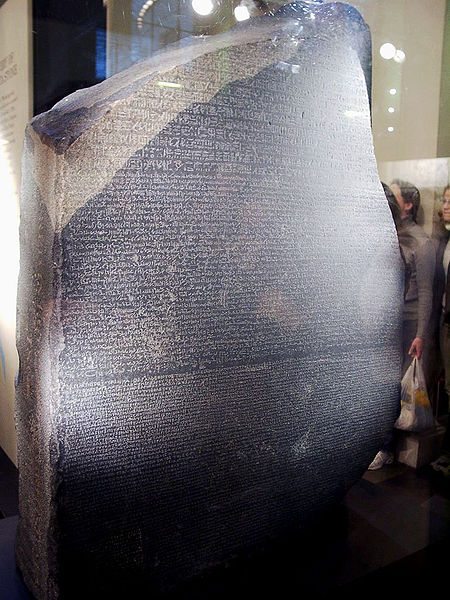Let's translate into 20 languages ...
Rosetta Stone

Rosetta Stone in the British Museum
In 1798. Napoleon began the trek to Egypt. Their military plans
were not accomplished, but the march to Egypt began the systematic
Scientific studies of this region. The military generals and 38,000 soldiers traveled in an abundant
group of scientists and artists. During an expedition to the Arab village outlets,
near the Nile, one of the soldiers dug out of the ground a black polished basalt board
spotted records. The stone was about 1.2 meters long and about 762 centimeters
wide. Later, the researchers assessed the "Rosetta stone" meaning: they found it
the first Egyptian language text together with an exact translation of the Greek language.
Rosetta Stone entries threefold: hieroglyphs, Egyptian and
Greek manuscript. Scientists rapidly translated the text written in the Greek language,
but hieroglyphs caused problems. After several decades of deciphering attempts which caused huge disappointments
The Frenchman Jean-François Champollion has finally taken.up to try and translate them.
When he was thirteen years old, Jean-François Champollion could already speak
Latin, Greek, Hebrew, Arabic, Syrien, Coptic, Chinese and Sanskrit
languages. While he was learning Easterners languages, he tried to know Eastern nations
psychology and mindset to approach the ancient Egyptian way of thinking.
Jean-François Champollion believed only way this difficult races key to their writing, and
language. In 1822. He devoted himself to this work and first deciphered
few Egyptian characters perskaitydamas Alexander and
several Roman emperors names of Egyptian texts. Ancient Egypt
writings were opened to readers.
Source: http://poliglotai.lt/2011/11/rozetes-akmuo/

The first translations
Septuagint (Latin Septuagint - seventy) - is the translation of the Old
Testament into the ancient Greek language. According to
the legend, the Septuagint was translated into the Greek language in Alexandria, Egypt by Jewish translators around
250-150 m. BC. me They had not met each other, but God inspired them to finish translating The Old |Testament in
the same way. Translation of the Bible was supported by the Egyptian king Ptolemy II
(285-247 m. Ave. Me). Septuagint introduced the Greeks to the Jewish religion,
history and culture. The translation quoting the Old Testament was based on
The Apostle Paul and other New Testament writers, he quoted the Church
Fathers. Septuagint is based on the Catholic Biblical canon.
What is consecutive interpreting?
Interpreter sits with delegates,
listens to the speeches and then recounts it in another language, usually based on
notes. Now the serial translation in many places has been replaced by
simultaneous, but sequential manner is still forced some
types of meetings (eg, highly technical meetings at work
south, in small groups, field trips).
Well prepared interpreters can accurately retell speeches of 10 minutes or longer.
Let's translate into 20 languages ...
Rosetta Stone
 |
Rosetta Stone in the British Museum
|
The first translations
Septuagint (Latin Septuagint - seventy) - is the translation of the Old
Testament into the ancient Greek language. According to
the legend, the Septuagint was translated into the Greek language in Alexandria, Egypt by Jewish translators around
250-150 m. BC. me They had not met each other, but God inspired them to finish translating The Old |Testament in
the same way. Translation of the Bible was supported by the Egyptian king Ptolemy II
(285-247 m. Ave. Me). Septuagint introduced the Greeks to the Jewish religion,
history and culture. The translation quoting the Old Testament was based on
The Apostle Paul and other New Testament writers, he quoted the Church
Fathers. Septuagint is based on the Catholic Biblical canon.
What is consecutive interpreting?
Interpreter sits with delegates, listens to the speeches and then recounts it in another language, usually based on notes. Now the serial translation in many places has been replaced by simultaneous, but sequential manner is still forced some types of meetings (eg, highly technical meetings at work south, in small groups, field trips).Well prepared interpreters can accurately retell speeches of 10 minutes or longer.
Komentarų nėra:
Rašyti komentarą